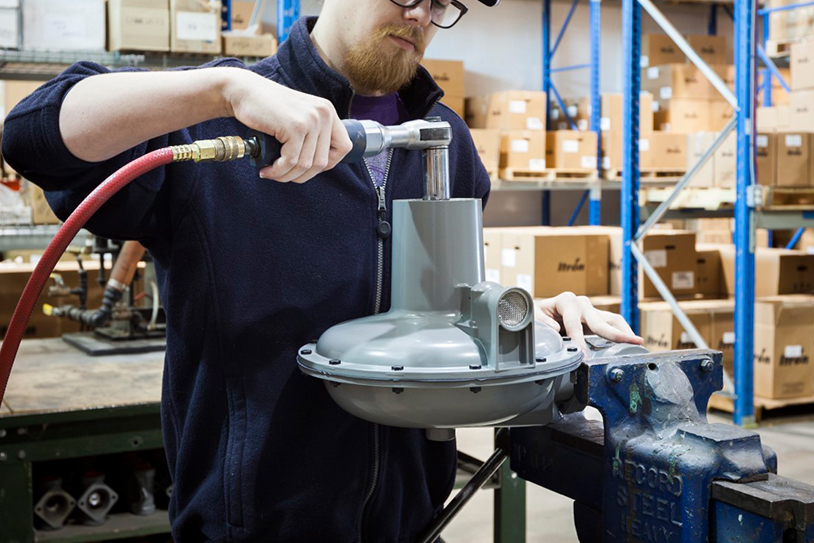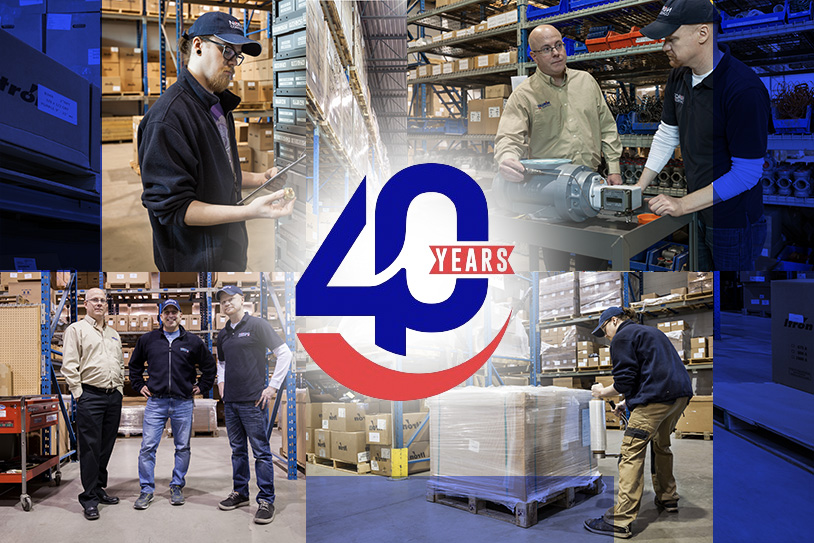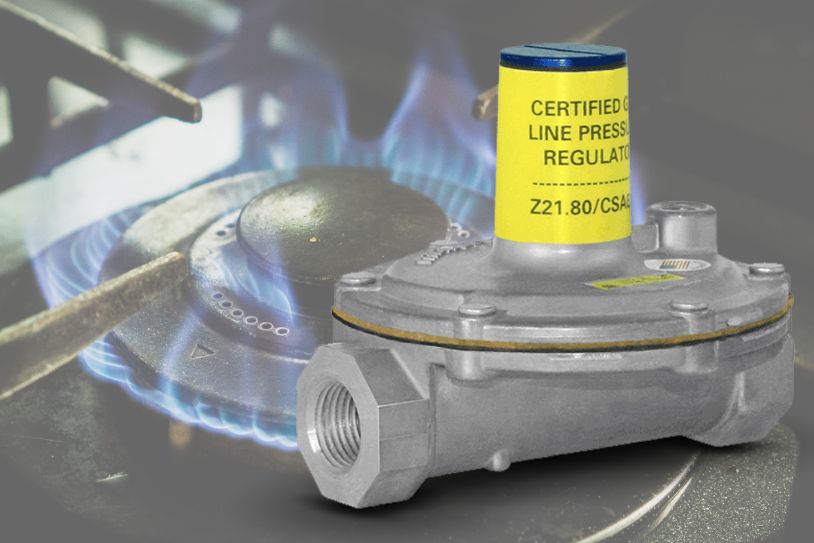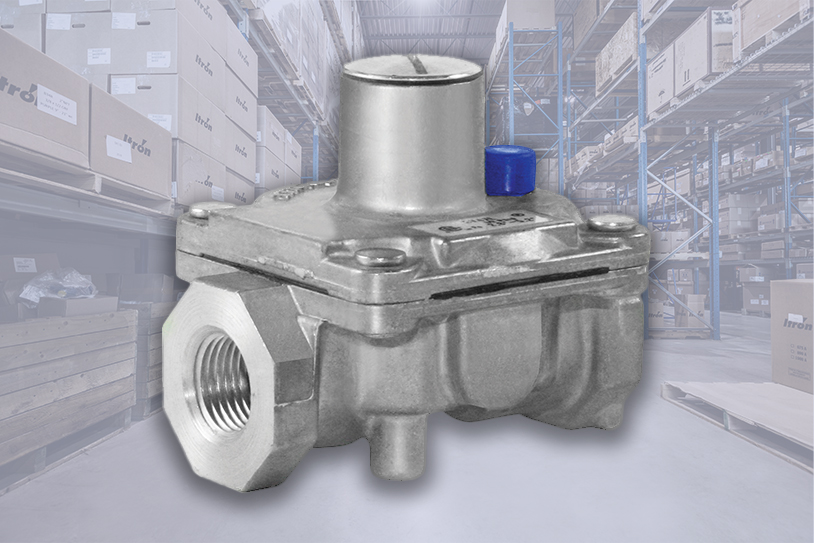How Does a Gas Regulator Work?

Working in the HVAC, combustion, propane, and industrial markets requires tools and equipment that can handle the demands of process complexity in a safe and efficient manner. One area you should never skimp on is that of your gas regulators.
These handy devices work hard to ensure the gas flowing through the lines into the equipment does so at the right pressure. Too much gas pressure can lead to a catastrophic explosion, harming others and destroying property. Conversely, not having enough pressure will render your equipment useless.
Learn the Basics of Gas Regulators to Make Better Decisions
We understand that the world of regulators can be a little confusing. Each type serves a different purpose based on the application. Although you can rely on experts like us to help you out, understanding what a regulator is, how it works, the difference between pressure reduction and pressure regulation, and dual-stage vs. single-stage, will aid you in finding the best product for the job.
Here is a breakdown of what you need to know about gas regulators, whether it’s a natural gas regulator or a propane gas regulator.
What is a Gas Regulator?
Designed in 1835, the regulator’s concept is easy, and its impact has been long-lasting. There are various types of regulators, but their function is the same: to use a valve system to control natural gas or propane pressure or other gas flow.
Common appliances that use regulators include gas stoves, propane grills, or oxy-fuel bottles for welding. Each type of regulator’s components consists of a set spring attached to a rod that runs down from a set screw through a diaphragm into the valve.
There are three primary operating components working together to regulate the pressure within the valve. The loading mechanism determines the delivery pressure. Most often, it is a spring. The sensing element, or diaphragm, senses the force against the spring. Finally, the control element accomplishes the reduction of the inlet pressure through to the outlet pressure.
How Does a Gas Regulator Work?
Gas enters the regulator’s chamber, putting pressure on the diaphragm. The diaphragm then moves upward as controlled by the set spring. This allows a specific flow of fuel from the source to the appliance or device. Adjusting the control knob determines the rate of flow and the pressure. Turning clockwise will push the diaphragm down and allow more gas to come into the valve. Turn counter-clockwise to reduce the amount of fuel and pressure.
B38 Series Line and Service Regulator from Itron
The mechanics of the gas regulator work well together. However, there is another component that comes into play called the surrounding air. Atmospheric pressure, based on the elevation above sea level that the building sits, will affect gas pressure. The inner parts work by sensing the pressure both upstream and downstream. The air pressure affects the way the regulator senses downstream pressure.
What is the Difference Between Pressure Reduction and Pressure Regulation?
The application between the two types is the main difference. A pressure reduction regulator is used to reduce the input pressure of the gas, so that it is at the ideal pressure on the outset. It is a normally open valve installed upstream of the pressure-sensitive equipment it needs to regulate, as it controls downstream pressure.
Pressure regulation is often called a back-pressure regulator or back-pressure valve. Its purpose is to maintain a set pressure at the inlet. It is a normally closed valve and is installed in parallel with or just after sensitive equipment to maintain upstream pressure.
See Norgas’ Selection of Gas regulators
Dual-Stage versus Single-Stage – Why Does it Matter?
Dual-stage regulators utilize two regulators within the same housing, which operate to reduce pressure in two steps instead of only one step. At the first stage, the pressure of the supply (inlet) gas is reduced at an intermediate stage, generally about three times the maximum working pressure. The second stage further reduces the pressure to a reasonable working pressure. Sometimes, a dual-stage regulator may have two safety valves to lessen the possibility of an explosion.
Dual-Stage Regulator (Source: Wikipedia – author: Mintrick.)
Single-stage regulators only have one regulator in which the gas supply enters, and the pressure is reduced. The delivery pressure is not as controllable as a dual-stage one is; thus, it should be used in operations where it can be monitored and easily adjusted as required, or the source pressure is nearly constant. An example of a single-stage regulator is a line regulator.
Single Stage Regulator (Source: Wikipedia – author: Mintrick.)
Choosing which type to use should be based on the required consistency of gas flow needed for operating. Consider what kind of gas flow is required, and then make your choice.
Types of Gas Regulators
The types of regulators are extensive and include appliance, line and service, pilot operated, direct acting, high pressure, back pressure, relief valves, and propane regulators. You can even find specialty items such as high-purity regulators for those unique jobs. At Norgas Controls, you can find the right type of regulator for your specific needs.
Finding The Right Gas Regulator
Norgas’ team of experts can help you find the right gas regulator for your application from our extensive inventory or design a custom solution to meet your specific needs. We have an extensive inventory of gas regulators ready to ship within 24-hours of your order.
Need to set up a quote for a client? Contact us. We will give you everything you need, from pricing to literature, to provide your customer with an accurate quote that will give you a leg up against the competition. We are your one-stop-shop for all your gas regulators, meters, valves, and accessories.
Call us at 514-697-8439 or 888-GAS-REGS (427-7347) for all your gas regulators, gas flow meters, and gas valve needs.







